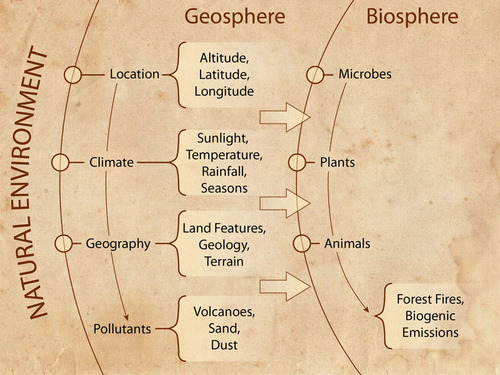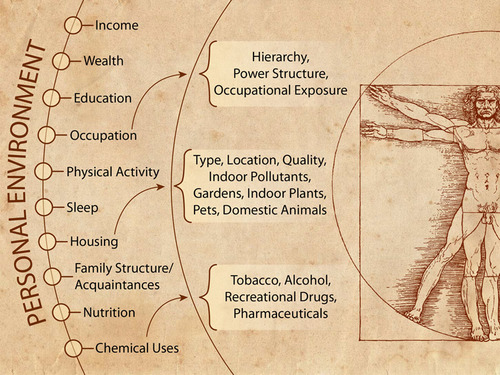The Envirome
Defining the Human Envirome
An Omics Approach for Assessing the Environmental Risk of Cardiovascular Disease
By Daniel W. Riggs, Ray A. Yeager, and Aruni Bhatnagar
Originally published April 27, 2018
The human envirome is made up of all the environmental conditions that affect us.
Both genetic and environmental factors contribute to a person’s wellbeing and disease risk. Until now, the environmental effects on health has not been studied. There is no framework to understand our environment as a whole (the envirome) or the interactions between the natural, social, and personal domains. To understand how the environment increases or decreases risk for developing heart disease we must understand the impact the envirome and its specific domains have on health.Read the entire manuscript here.
The envirome is made up of everything around us.
- Natural Environment: everything that is not man-made like the weather, mountains and rivers, and plants and animals.
- Social Environment: how we organize ourselves into a society and build cities.
- Personal Environment: the lives we to build for ourselves, where we live, what we eat, and whether we chose to exercise or smoke.
The Envirome is made up of three inter-related types of environment – the natural, social, and personal domains of the external environment. Our characteristics come from interactions between our genes and our environments- both our envirome now and past enviromes that shaped our ancestors. The envirome shapes everything about a person, from their mental and physical development to disease risk and life span.
Natural Environment
The Natural environment includes cycles of night and day, rhythms of the seasons, altitude, latitude, and variations in exposure to sunshine and greenspaces profoundly affect human health and well-being.

Social Environment
The influence of the natural environment features is deeply transformed by urbanization through the social environment. The social environment includes the built environment, agricultural and industrial activities and pollution as well as culture, economic activities, and social networks. Through exposure to traffic, pollution, and occupational hazards, urbanization limits human health and creates disease risk. Moreover, large social networks cause disease inequities and health disparities by influencing access to healthcare, social cohesion, and socioeconomic status.

Personal Environment
Within the social environment, individuals create personal environments through individual lifestyle choices that improve their status or provide protection from threatening natural and social influences. Every personal environment is different, characterized by income, education, and lifestyle choices relating to nutrition, physical activity, sleep, and the use of recreational drugs, alcohol, and tobacco.

Why it Matters
The interactions between genetic and environmental factors enable human development and contribute to a person's wellbeing and disease risk. But, until now, how the environmental effects health has received little attention. Evaluation of environmental determinants of disease is limited by the lack of comprehensive omics approaches for integrating multiple environmental exposures. Hence, to understand the effects of the environment as a whole (envirome), it is important to delineate specific domains of the environment and to decipher the relationships between these domains, and how they individually and collectively affect human health. We are guided by a hierarchical model of the structure of the human envirome; defined by 3 consecutively nested domains, consisting of natural, social, and personal environments. Extensive evidence suggests that features of the natural environment such as sunlight, altitude, diurnal rhythms, vegetation, and biodiversity affect cardiovascular health. However, the effects of the natural environment are moderated by the social environment comprised of built environments, agricultural and industrial activities, pollutants and contaminants, as well as culture, economic activities, and social networks that affect health by influencing access to healthcare, social cohesion, and socioeconomic status. From resources available within society, individuals create personal environments, characterized by private income, wealth and education, and populated by behavioral and lifestyle choices relating to nutrition, physical activity, sleep, the use of recreational drugs, and smoking. An understanding of the interactions between different domains of the envirome and their integrated effects on cardiovascular health could lead to the development of new prevention strategies and deeper insights into etiologic processes that contribute to cardiovascular disease risk and susceptibility.
Background and Context
A conducive environment is essential for human health and well-being. It enables and orchestrates human development and it exerts a profound influence on human fitness and disease risk. But the human environment is complex; it includes not only the physical elements of geography and ecology, but also large social networks fashioned by unique combinations of history and culture. These components of the environment conform to a discernable structure that links discrete elements of the environment together. These features and the structure of environmental elements exert their influence on humans via their many interactive domains. Of these, nature is the most primordial domain of the human environment. Ecological features such as the cycles of night and day, the rhythms of the seasons, the gradations in altitude and latitude, and the variations in exposure to sunshine and greenspaces profoundly affect human health and well-being. In advanced human societies, the influence of these natural features is deeply transformed by urbanization. With its attendant exposures to traffic, pollution, and occupational hazards, urbanization limits human health and imposes disease risk. Moreover, by imparting variable socioeconomic status and by creating large social networks, these societies generate disease inequities and health disparities. Within these social networks; however, humans create unique personal environments populated by individual lifestyle choices to shield themselves from adverse social and natural influences or to enhance their positive impact.
Hence, to understand, assess, and ameliorate the effects of the environment on health, it is critical not only to evaluate the impact of natural, social and personal domains of the environment, but to assess how these domains interact with each other and how they individually and collectively bear upon human health. Such integrative effects of the environment have not been evaluated before.
